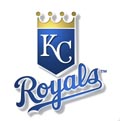 Another National League team comes to town -- for the moment I'll ignore that it's the Cardinals, who the Royals trounced last night like it was Game 7 of the 1985 World Series -- and that means it's time for one thing: FEAST!
Another National League team comes to town -- for the moment I'll ignore that it's the Cardinals, who the Royals trounced last night like it was Game 7 of the 1985 World Series -- and that means it's time for one thing: FEAST!The Royals are now 5-2 against the NL this season and 81-101 (44.5 percent) since Interleague play began in 1997, a marked improvement from their 41.1 winning percentage in that stretch. They fit the trend of American League teams beating up on their Quadruple-A counterparts: while we can't expect a 154-98 discrepancy between the two leagues this year, so far the AL is 58-42, running their three-year record to an astounding 348-246. Our brethren to the east are beginning to hate us.
April of last year, Tom Verducci of Sports Illustrated penned an article subtitled, "Teams from the National League have been dominated by their American League counterparts in recent years, by almost every measure, and the trend will only continue this season. How did this happen?" Among the interesting explanations:
THE MONEYBALL THEORY
"There aren't as many great athletes playing baseball, especially as artificial turf came out of the game," the advance scout says. "You used to go to Kansas City, St. Louis, Pittsburgh, Cincinnati and Toronto and see so many really good athletes. That's not what the game is now. And I think the AL made that transition quicker than the NL."
In this regard, the designated hitter really has made a significant difference. The AL is a more offense-driven league, and as Billy Beane and Paul DePodesta discovered several years back, a baseball team trying to win in an unfair game -- this still applies in the age of the luxury tax -- can best improve by upgrading their offense. That means OBP and OPS guys: sluggers who draw walks. Other AL GMs such as Mark Shapiro of Cleveland, Brian Cashman of New York and Theo Epstein of Boston have embraced this notion, whereas the NL have been slow to embrace sabermetrics (DePodesta got axed by the Dodgers after a monkey trial and is currently a "special assistant" with the Padres).
Tony LaRussa, the model of the "traditional" way of playing that so titillates baseball's purists -- at least in Buzz Bissinger's eyes -- can be Exhibit A in why the NL has been behind the curve. (I should point out that SI recently did a long feature on LaRussa, complete with ridiculous quotes like this from Tino Martinez: "He thought his best way to win that day was to sacrifice the catcher so the pitcher comes up -- the kind of moves you think are crazy when you're playing for him. There's a reason behind it: The pitcher's usually going to lay a bunt down regardless... and you don't realize Tony's trying to stay out of a double play and turn the lineup over for the next inning." Uh, so sacrificing two outs: good strategy. Gotcha.) Whereas teams like St. Louis still believe the manager is important, franchises in the AL have long begun to see that it's the front office that matters. Notice that the name of this blog is In Dayton We Trust, not Buddy Bell, no matter how great a person he is.
Granted, NL games may be more fun to watch -- the pitcher's spot, for some reason, tempts managers to try all sorts of wacky things, like hit-and-run -- but it doesn't bode well for winning over 162 games. It starts with a mindset, and by and large AL teams have the right mindset while NL teams do not.
THE PULL OF SUPERNOVAS
Adds Shapiro, "With their resources, you almost expect Boston and New York to win 95 to 100 games every year. That makes the competition that much harder for everybody else."Just look at what happened this winter. Every team in the American League added payroll. Some went up dramatically, like Chicago, Detroit and Toronto. Then you look at the National League and you had teams that pulled back, like Arizona, Atlanta, Houston, Cincinnati, Colorado and Florida. You didn't see anybody in the AL pulling back."
It really is that straightforward. Seven of the top 10 payrolls in baseball are owned by American League teams, while six of the bottom seven are from the NL. Now, we know money isn't everything, but when the bottom six include the likes of Colorado, Pittsburgh and Washington, the reasons for the AL-NL discrepancy become clearer. (The Tampa Bay Devil Rays, owner of baseball's lowest payroll, have as good a chance as any team in the AL East -- perhaps better -- to challenge New York and Boston in the coming years. With the addition of David Price, Tampa Bay's farm is officially stacked.)
***
A more comprehensive study of this issue was performed by Mitchel Lichtman of the Hardball Times. It's actually a three-part series, so I'll link the final part here and you can cycle back. It's text- and number-heavy, so if you're looking for the synopsis, I recommend this post from Phil Birnbaum of Sabermetric Research.Now let's turn those redbirds into I-70 roadkill. (I know, I'm so clever...)
POSTSCRIPT: Brian Bannister has pitched 17 consecutive scoreless innings. Just 42 more to go to catch Orel Hershiser.


No comments:
Post a Comment